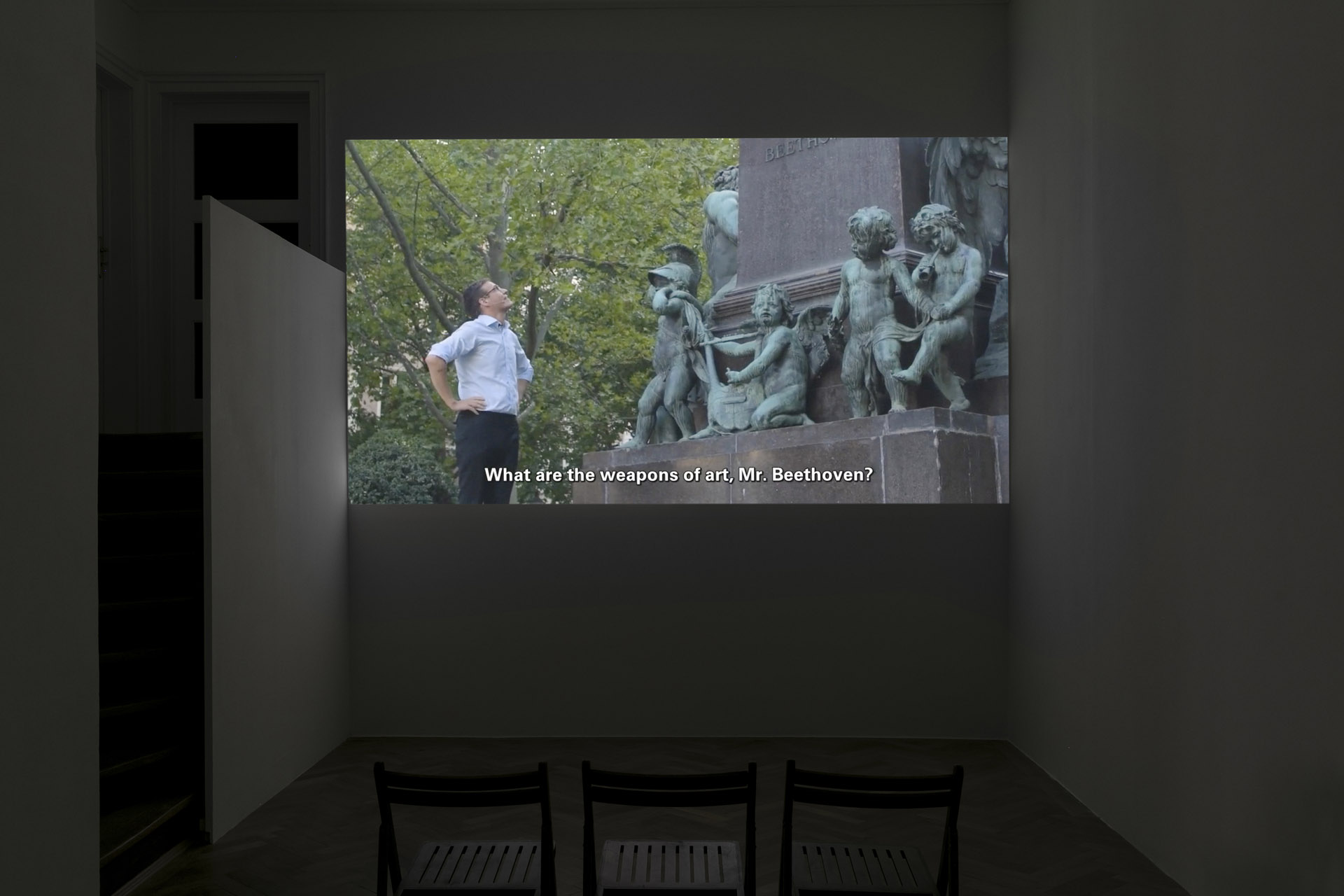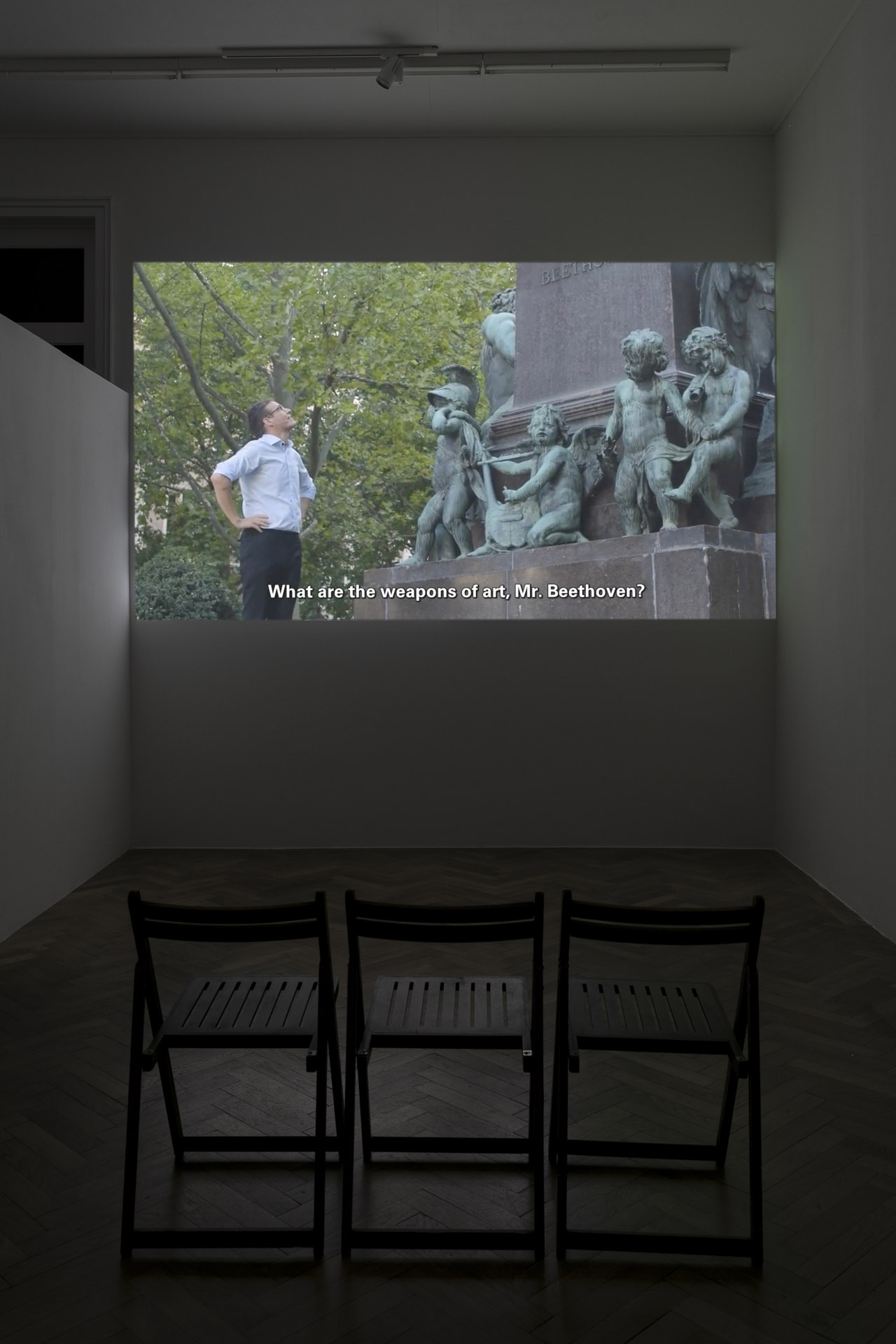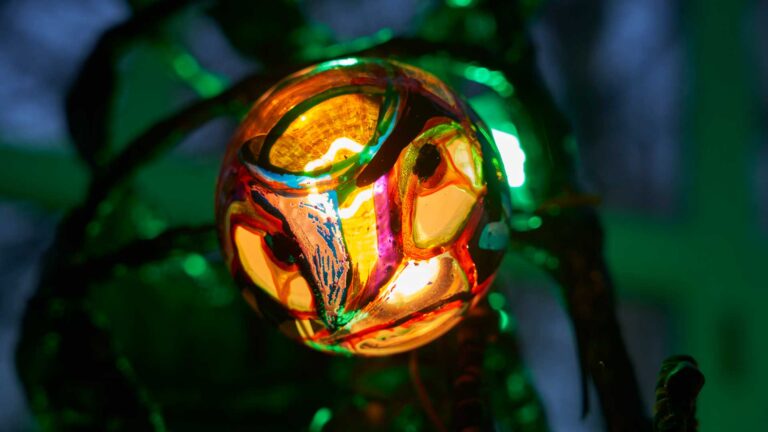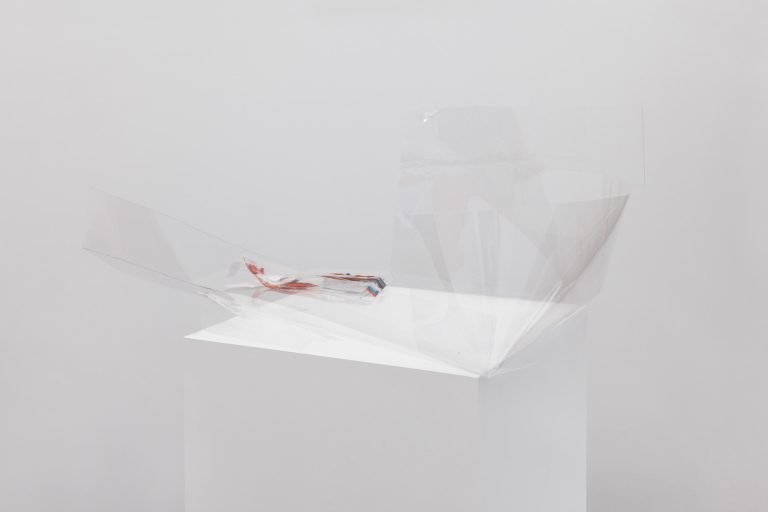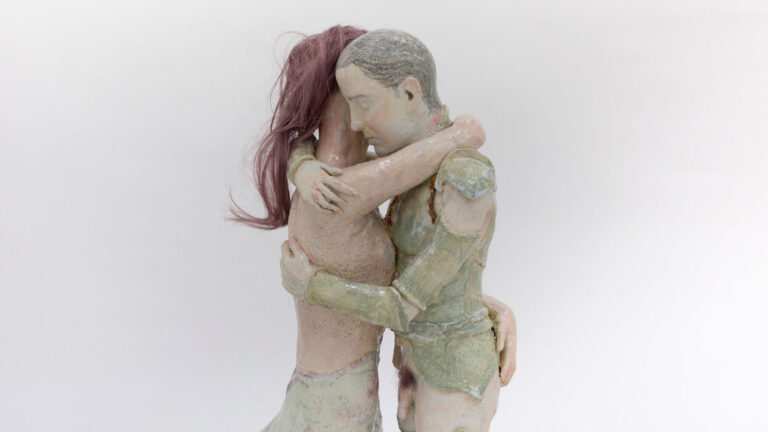Artist: Thomas Geiger
Exhibition title: The Ghost is present
Venue: SPERLING, Munich, Germany
Date: March 26 – May 22, 2021
Photography: ©the artist. Courtesy of SPERLING, Munich. Photos by Sebastian Kissel
The Ghost is Present
There is no evidence that the words guest and host are etymologically connected with the word ghost*. While guests and hosts are graspable beings whose relation constitutes the problem of hospitality, ghosts are ambivalent figures. The ghost is present somewhere between me and you. It is a familiar-other who embodies the tension between the personal and the collective. The ghost is a performer who possesses a strange, timeless authority. The public is transfixed in awaiting its speech. The ghost is a host that teaches the social imaginary and gives advice on how to live. The ghost is a guest whose hosting is a risky endeavor. It remembers things that nobody else remembers and it might want to say them forever.
Ghosts are also known to be invisible, although many believe that they manifest in things. Things on the other hand, despite being material, often remain unnoticed themselves. Think about public statues. We pass next to them on the street, in the library, or at the university, in a museum, sometimes they are even part of the building that we live or work in. But unless they are contested, busts, monuments and other public sculptures done at one time for posterity remain unseen in our contemporary everyday life. Such an invisibility can have its advantages, of course. While being invisible, a ghost can sit and watch the life of others and thrill to it, without them knowing that it is there, until one gives them attention. One might, for example, attempt to talk to a ghost, as Thomas Geiger does in his performance series Bust Talks. There is, however, still no evidence that ghosts exist in public.
Thomas Geiger‘s Bust Talks are in a way contemporary séances that follow the decorum of a talk show. With the interview being his tool, Geiger investigates what the present might have in common with the past by questioning its witnesses. He treats objects as subjects and gives them attention that they otherwise would not receive. The protagonists in Bust Talks are not always angels; their study provides a lesson in confronting contradictions and looking at history from different perspectives. In specific episodes, the show is about how to talk to someone with whom you disagree – with Dr. Hans Klöpfer, understanding otherness and belonging – with Kifwebe, providing a stage for a reinterpretation of her story – with Mutter, imagining better futures – with Friedrich Wilhelm Raiffeisen, and revising ideas about the freedom of art and its usefulness – with Ludwig van Beethoven. Performance becomes here a stage for debate and discourse and a hospitable situation in which everybody can see and hear from different positions. Above all, Bust Talks make clear that if there is something that a guest, a ghost and a host have in common, it is how they all play into the process of the renegotiation of identity.
It is common knowledge that hospitality can take different directions and lead to different results. At its best, the act of hospitality is about self-othering, it is a counterforce to narcissism, and a process resulting in mutual recognition, that might lead to a transformation of the self. At its worst, however, hospitality is relation of power, a game of separating oneself from the other in multiple ways. It can manifest in an exertion of control over the guest out of fear about the loss of one’s power and identity. In practice the positions of guests and hosts constantly fluctuate. A guest can turn into a host, or into a ghost, who can once again turn into either guest or host, and again, forevermore.
Text by Mirela Baciak
*In 1953 Marcel Duchamp proposed a witty equation: A Guest + A Host = A Ghost indicating a somewhat magical merging of the two figures of hospitality into an entity between the self and other.
Thomas Geiger – Bust Talks
Busts and statues are the constant observers of public space and its inhabitants. As such, they transcend different times and accumulate an enormous wealth of knowledge and experience. Thomas Geiger makes this potential available through his work Bust Talks and creates a new perspective on the present by giving voice to the past. The ongoing performance series is based on the assumption that busts and statues are not just cold and soulless objects, but potential interlocutors. In an interview situation, Geiger meets his interlocutors as a critical questioner. In doing so, he receives the silent answers of my counterparts and pass them on to the audience. Previous interviewees have included a West African Songye mask with an unclear provenance (Kunsthalle Emden, 2019), Ludwig van Beethoven (Wiener Festwochen), the wall relief of a female nude (Blackforest Institute of Art, 2020), the Nazi poet Hans Kloepfer (steirischer Herbst, 2019), and an anonymous female figure on the tomb of Johann Jakob Bachofen (Ausstellungsraum Klingental, Basel, 2020).
Bust Talk–Ludwig van Beethoven
Ludwig van Beethoven is known to us all as a great composer. But he also had a keen interest in economics and was concerned about fair payment for artists. What is the value of artistic work to society? The conversation with Beethoven not only revolves around these question, but also leads to the role of art itself in and for society.
– Wiener Festwochen, 2020, 24:05 min
Bust Talk–Kifwebe
This conversation was with an East African Songye mask that has been in the museum‘s possession for several years through a donation. The provenance of the mask is unclear. The conversation is about its origin and its new home in the museum.
– Kunsthalle Emden, 2019, 18:52 min
Bust Talk-Hans Kloepfer
Hans Kloepfer was a doctor and local poet and is still an important identity figure in Styria today. But he was also a convinced National Socialist and that from the first hour. Nevertheless, a bust of him stands on the Schlossberg in Graz, among other places. The conversation turned energetically around the question of whether a bust of a follower and supporter of a criminal regime should be allowed to remain standing in another time.
– steirischer herbst, 2019, 26:00 min
Bust Talk Pietro
Pietro is the name of the female nude in the entrance of the Black Forest Institute of Arts in Lenzkirch. It is a sculpture by the German sculptor Emil Sutors, who gained notoriety with his monuments to war heroes. The conversation leads through idealized bodies to the question of nudes and nudity and the discussion of whether a representation is sexist or rather the view of the viewer. Pietro repeatedly and ingeniously picks on the questioner, sets traps for him and clearly enjoys putting his foot in his mouth.
– Black Forest Institute of Art, 2020, 19:30 min
Bust Talk–Mutter
This conversation took place with an anonymous woman sitting on the grave of Johann Jakob Bachofen. Bachofen is the author of „The Mother‘s Right,“ a controversial book about how an early matriarchy evolved into a culturally superior patriarchy. Our conversation is not only about Bachofen, but also about the appearance and use of allegories within statutes and sculptures.
– Ausstellungsraum Klingental, Basel, 2020, 23:40 min
Thomas Geiger, The Ghost is present, 2021, exhibition view, SPERLING, Munich
Thomas Geiger, The Ghost is present, 2021, exhibition view, SPERLING, Munich
Thomas Geiger, The Ghost is present, 2021, exhibition view, SPERLING, Munich
Thomas Geiger, The Ghost is present, 2021, exhibition view, SPERLING, Munich
Thomas Geiger, The Ghost is present, 2021, exhibition view, SPERLING, Munich
Thomas Geiger, The Ghost is present, 2021, exhibition view, SPERLING, Munich
Thomas Geiger, The Ghost is present, 2021, exhibition view, SPERLING, Munich
Thomas Geiger, The Ghost is present, 2021, exhibition view, SPERLING, Munich
Thomas Geiger, The Ghost is present, 2021, exhibition view, SPERLING, Munich
Thomas Geiger, The Ghost is present, 2021, exhibition view, SPERLING, Munich
Thomas Geiger, The Ghost is present, 2021, exhibition view, SPERLING, Munich
Thomas Geiger, The Ghost is present, 2021, video still, SPERLING, Munich
Thomas Geiger, The Ghost is present, 2021, video still, SPERLING, Munich
Thomas Geiger, The Ghost is present, 2021, video still, SPERLING, Munich
Thomas Geiger, Bust Talk – Kifwebe, 2018, Video, 18:52 min. This conversation was with an East African Songye mask that has been in the museum‘s possession for several years through a donation. The provenance of the mask is unclear. The conversation is about its origin and its new home in the museum.
Thomas Geiger, Bust Talk – Hans Kloepfer, 2019, Video, 26:00 min. Hans Kloepfer was a doctor and local poet and is still an important identity figure in Styria today. But he was also a convinced National Socialist and that from the first hour. Nevertheless, a bust of him stands on the Schlossberg in Graz, among other places. The conversation turned energetically around the question of whether a bust of a follower and supporter of a criminal regime should be allowed to remain standing in another time.
Thomas Geiger, Bust Talk – Pietro, 2020, Video, 19:30 min. Pietro is the name of the female nude in the entrance of the Black Forest Institute of Arts in Lenzkirch. It is a sculpture by the German sculptor Emil Sutors, who gained notoriety with his monuments to war heroes. The conversation leads through idealized bodies to the question of nudes and nudity and the discussion of whether a representation is sexist or rather the view of the viewer. Pietro repeatedly and ingeniously picks on the questioner, sets traps for him and clearly enjoys putting his foot in his mouth.
Thomas Geiger, Bust Talk – Ludwig van Beethoven, 2020, Video, 24:05 min. Ludwig van Beethoven is known to us all as a great composer. But he also had a keen interest in economics and was concerned about fair payment for artists. What is the value of artistic work to society? The conversation with Beethoven not only revolves around these question, but also leads to the role of art itself in and for society.
Thomas Geiger, Bust Talk – Mutter, 2020, Video, 23:40 min. This conversation took place with an anonymous woman sitting on the grave of Johann Jakob Bachofen. Bachofen is the author of „The Mother‘s Right,“ a controversial book about how an early matriarchy evolved into a culturally superior patriarchy. Our conversation is not only about Bachofen, but also about the appearance and use of allegories within statutes and sculptures.


